AFD System: Agile Methodologies, UCD, and Design Implementation
VerifiedAdded on 2024/05/14
|20
|3630
|258
Report
AI Summary
This report provides a comprehensive analysis of methodologies for developing the Australian Fashion Designs (AFD) system, which manages stock, representatives, and purchasing. It begins by describing various agile and iterative methodologies, recommending the Agile approach for its flexibility and focus on customer satisfaction. The report then discusses the User Centered Design (UCD) approach and its implications for the CRM application, emphasizing the importance of user-friendly interfaces and incorporating user feedback. A plan for UCD-informed Human Computer Interaction (HCL) is presented, suggesting its integration with the Agile methodology. The report includes an event table supporting business processes, along with domain and design class diagrams, and use case diagrams and descriptions. The ultimate recommendation is to adopt UCD principles alongside Agile methodology to develop a system that enhances both customer experience and organizational efficiency.
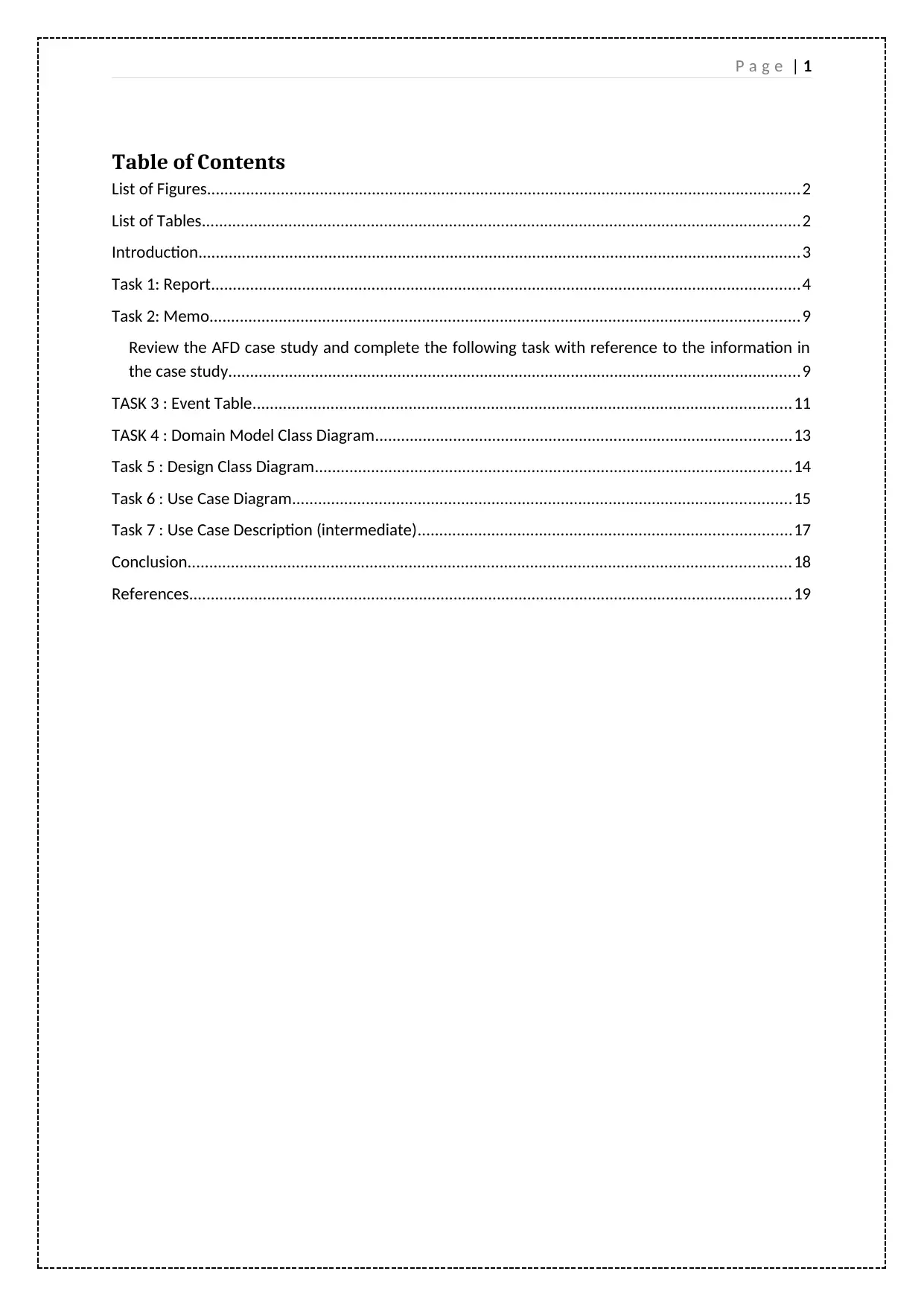
P a g e | 1
Table of Contents
List of Figures.........................................................................................................................................2
List of Tables..........................................................................................................................................2
Introduction...........................................................................................................................................3
Task 1: Report........................................................................................................................................4
Task 2: Memo........................................................................................................................................9
Review the AFD case study and complete the following task with reference to the information in
the case study....................................................................................................................................9
TASK 3 : Event Table............................................................................................................................11
TASK 4 : Domain Model Class Diagram................................................................................................13
Task 5 : Design Class Diagram..............................................................................................................14
Task 6 : Use Case Diagram...................................................................................................................15
Task 7 : Use Case Description (intermediate)......................................................................................17
Conclusion...........................................................................................................................................18
References...........................................................................................................................................19
Table of Contents
List of Figures.........................................................................................................................................2
List of Tables..........................................................................................................................................2
Introduction...........................................................................................................................................3
Task 1: Report........................................................................................................................................4
Task 2: Memo........................................................................................................................................9
Review the AFD case study and complete the following task with reference to the information in
the case study....................................................................................................................................9
TASK 3 : Event Table............................................................................................................................11
TASK 4 : Domain Model Class Diagram................................................................................................13
Task 5 : Design Class Diagram..............................................................................................................14
Task 6 : Use Case Diagram...................................................................................................................15
Task 7 : Use Case Description (intermediate)......................................................................................17
Conclusion...........................................................................................................................................18
References...........................................................................................................................................19
Paraphrase This Document
Need a fresh take? Get an instant paraphrase of this document with our AI Paraphraser
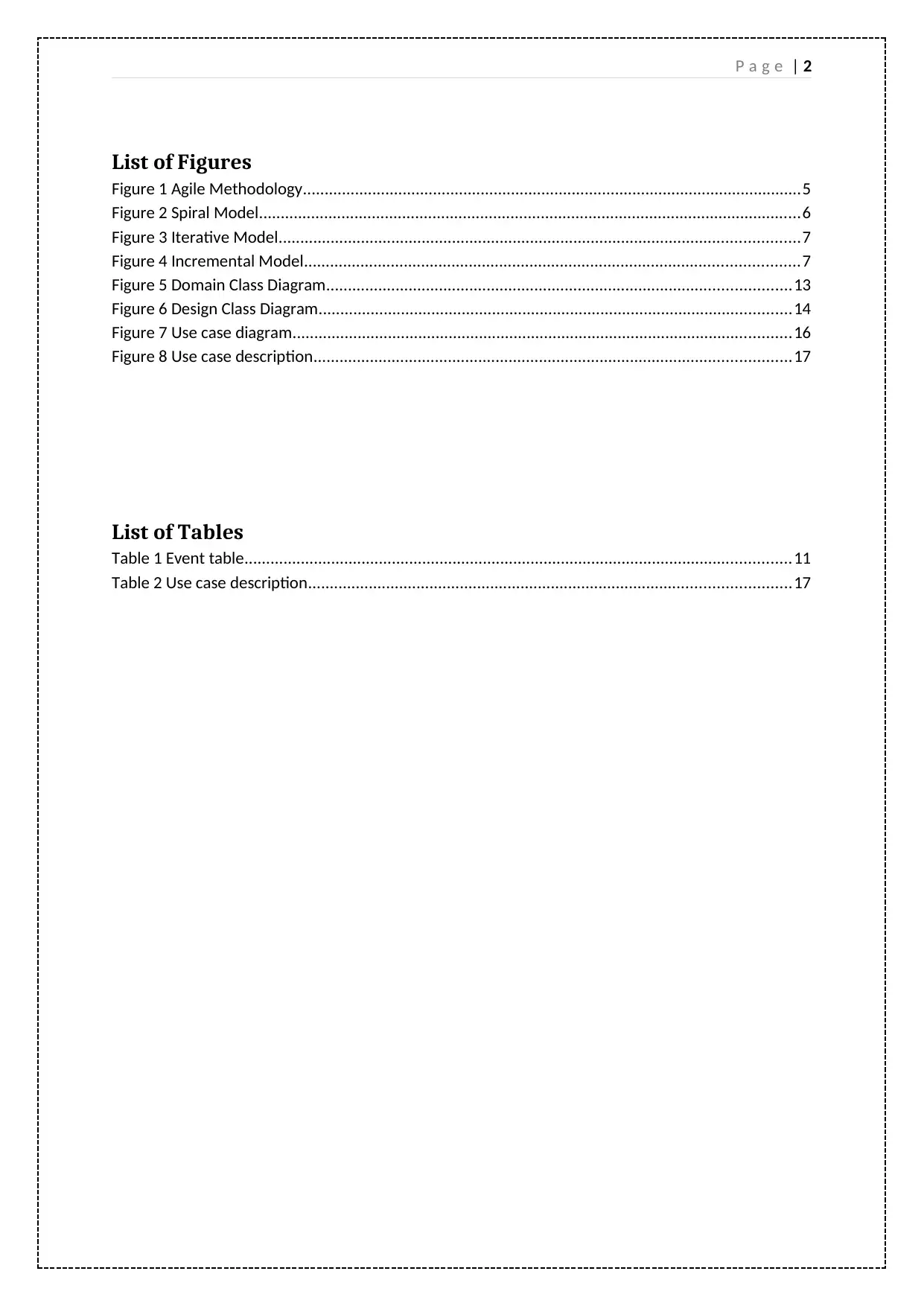
P a g e | 2
List of Figures
Figure 1 Agile Methodology...................................................................................................................5
Figure 2 Spiral Model.............................................................................................................................6
Figure 3 Iterative Model........................................................................................................................7
Figure 4 Incremental Model..................................................................................................................7
Figure 5 Domain Class Diagram...........................................................................................................13
Figure 6 Design Class Diagram.............................................................................................................14
Figure 7 Use case diagram...................................................................................................................16
Figure 8 Use case description..............................................................................................................17
List of Tables
Table 1 Event table..............................................................................................................................11
Table 2 Use case description...............................................................................................................17
List of Figures
Figure 1 Agile Methodology...................................................................................................................5
Figure 2 Spiral Model.............................................................................................................................6
Figure 3 Iterative Model........................................................................................................................7
Figure 4 Incremental Model..................................................................................................................7
Figure 5 Domain Class Diagram...........................................................................................................13
Figure 6 Design Class Diagram.............................................................................................................14
Figure 7 Use case diagram...................................................................................................................16
Figure 8 Use case description..............................................................................................................17
List of Tables
Table 1 Event table..............................................................................................................................11
Table 2 Use case description...............................................................................................................17
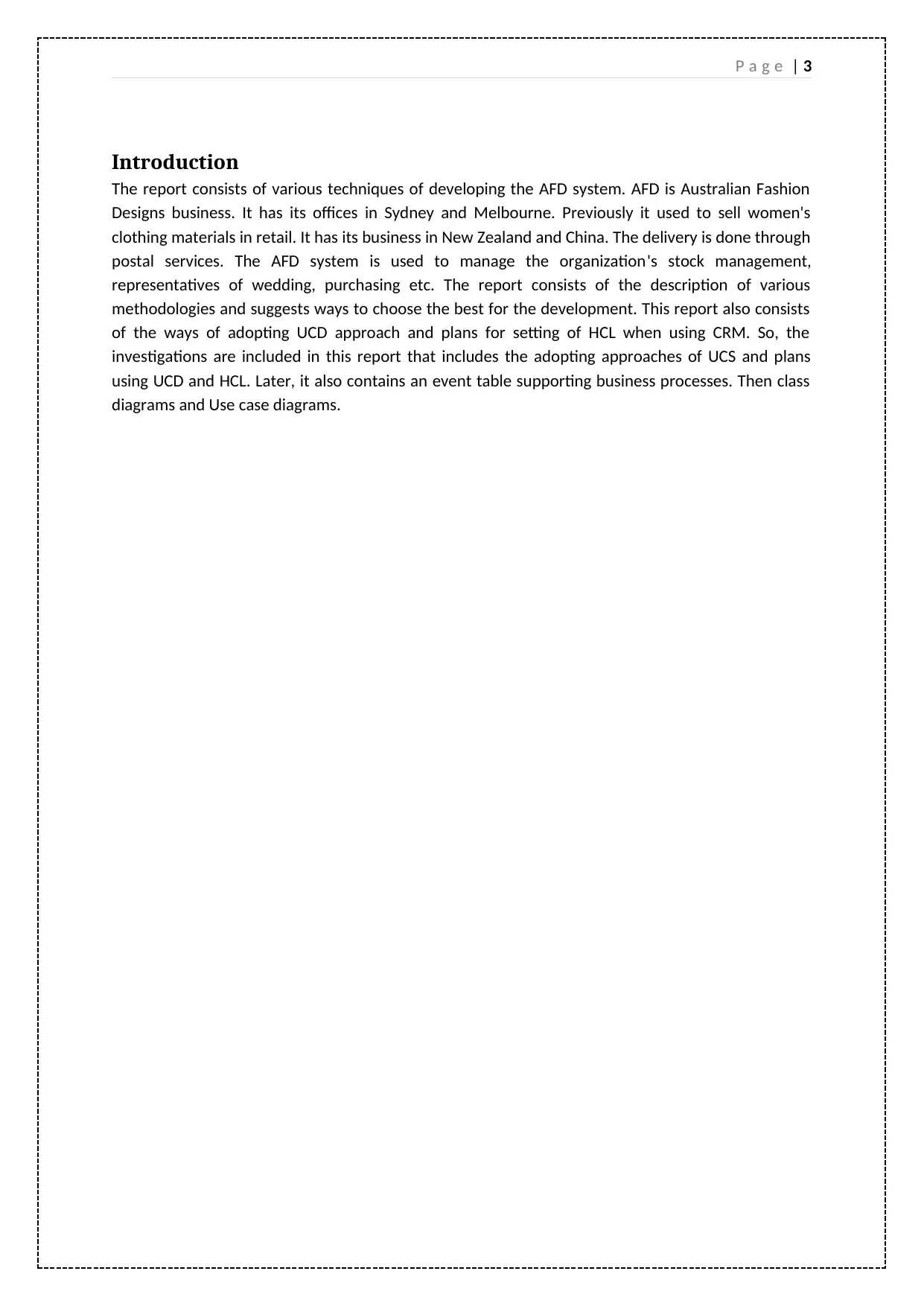
P a g e | 3
Introduction
The report consists of various techniques of developing the AFD system. AFD is Australian Fashion
Designs business. It has its offices in Sydney and Melbourne. Previously it used to sell women's
clothing materials in retail. It has its business in New Zealand and China. The delivery is done through
postal services. The AFD system is used to manage the organization's stock management,
representatives of wedding, purchasing etc. The report consists of the description of various
methodologies and suggests ways to choose the best for the development. This report also consists
of the ways of adopting UCD approach and plans for setting of HCL when using CRM. So, the
investigations are included in this report that includes the adopting approaches of UCS and plans
using UCD and HCL. Later, it also contains an event table supporting business processes. Then class
diagrams and Use case diagrams.
Introduction
The report consists of various techniques of developing the AFD system. AFD is Australian Fashion
Designs business. It has its offices in Sydney and Melbourne. Previously it used to sell women's
clothing materials in retail. It has its business in New Zealand and China. The delivery is done through
postal services. The AFD system is used to manage the organization's stock management,
representatives of wedding, purchasing etc. The report consists of the description of various
methodologies and suggests ways to choose the best for the development. This report also consists
of the ways of adopting UCD approach and plans for setting of HCL when using CRM. So, the
investigations are included in this report that includes the adopting approaches of UCS and plans
using UCD and HCL. Later, it also contains an event table supporting business processes. Then class
diagrams and Use case diagrams.
⊘ This is a preview!⊘
Do you want full access?
Subscribe today to unlock all pages.

Trusted by 1+ million students worldwide

P a g e | 4
Task 1: Report
There are various methodologies available in the market that can implement the AFD business
process. The management team of the AFD knows a little about iterative and agile development
methodologies. So, this report consists of description of the different methodologies of iterative and
agile techniques. This will help them understanding various methods of development. With this they
will be able to choose the appropriate method of development. The detailed study of the case is
done to understand the needs of the system in the AFD organization. The Agile is a result focused
method of development. It is a fast and flexible process. It is based on the waterfall model. The
development team works with the customers to develop the business. The iterative works on
simplified development which progressively complexes to complete the process. Various techniques
of agile and iterative development are given below:
1. Agile Approach:
It is an incremental model. The system is developed in an incremental order in fast cycles.
Due to this, incremental outputs are released. Each incremented process is based on the
output of the previous incremental process. Every release is made to test so as to ensure the
quality of the software. It is mainly used for hard time applications. Adaptive planning
followed by progressive development is done in this type of approach.
Advantages of Agile approach:
Being a rapid and continuous process, the customer satisfaction is gained.
Working models are delivered more frequently.
Continuous attention is needed for technical excellence.
Any change in the requirements can be adopted easily.
It will help the management of the AFD in managing the purchases, transactions etc.
A user friendly interface is provided to the users.
Disadvantages of Agile approach:
Less importance is given to documentation and designing.
Chances of getting project out of track in case of unclear requirements.
Only senior members are allowed to take decisions.
It becomes difficult to calculate the efforts used at the beginning of the project in
case of large projects.
It costs more so AFD team will have to opt for the tenders (Abrahamsson et al.,
2018).
Task 1: Report
There are various methodologies available in the market that can implement the AFD business
process. The management team of the AFD knows a little about iterative and agile development
methodologies. So, this report consists of description of the different methodologies of iterative and
agile techniques. This will help them understanding various methods of development. With this they
will be able to choose the appropriate method of development. The detailed study of the case is
done to understand the needs of the system in the AFD organization. The Agile is a result focused
method of development. It is a fast and flexible process. It is based on the waterfall model. The
development team works with the customers to develop the business. The iterative works on
simplified development which progressively complexes to complete the process. Various techniques
of agile and iterative development are given below:
1. Agile Approach:
It is an incremental model. The system is developed in an incremental order in fast cycles.
Due to this, incremental outputs are released. Each incremented process is based on the
output of the previous incremental process. Every release is made to test so as to ensure the
quality of the software. It is mainly used for hard time applications. Adaptive planning
followed by progressive development is done in this type of approach.
Advantages of Agile approach:
Being a rapid and continuous process, the customer satisfaction is gained.
Working models are delivered more frequently.
Continuous attention is needed for technical excellence.
Any change in the requirements can be adopted easily.
It will help the management of the AFD in managing the purchases, transactions etc.
A user friendly interface is provided to the users.
Disadvantages of Agile approach:
Less importance is given to documentation and designing.
Chances of getting project out of track in case of unclear requirements.
Only senior members are allowed to take decisions.
It becomes difficult to calculate the efforts used at the beginning of the project in
case of large projects.
It costs more so AFD team will have to opt for the tenders (Abrahamsson et al.,
2018).
Paraphrase This Document
Need a fresh take? Get an instant paraphrase of this document with our AI Paraphraser
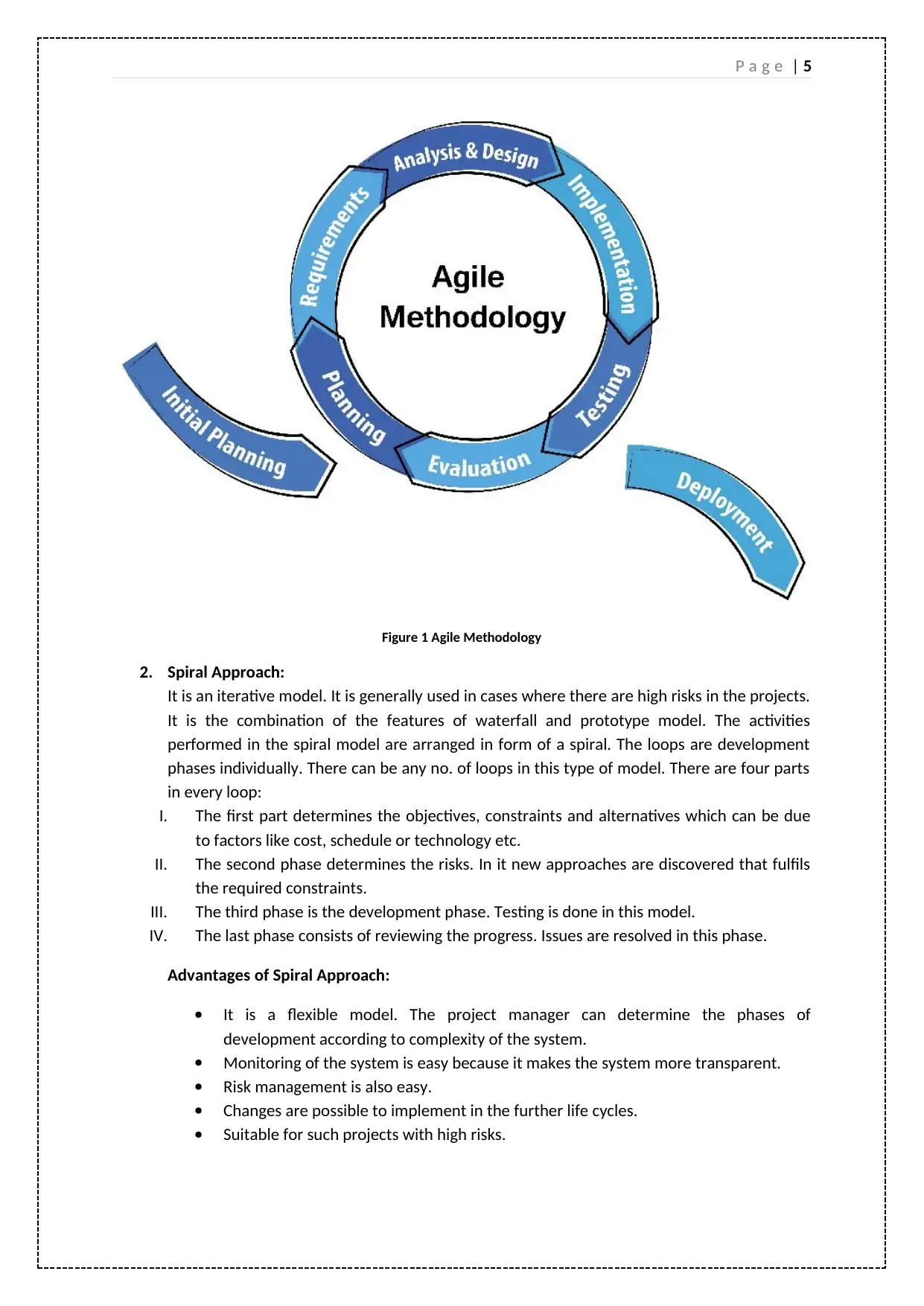
P a g e | 5
Figure 1 Agile Methodology
2. Spiral Approach:
It is an iterative model. It is generally used in cases where there are high risks in the projects.
It is the combination of the features of waterfall and prototype model. The activities
performed in the spiral model are arranged in form of a spiral. The loops are development
phases individually. There can be any no. of loops in this type of model. There are four parts
in every loop:
I. The first part determines the objectives, constraints and alternatives which can be due
to factors like cost, schedule or technology etc.
II. The second phase determines the risks. In it new approaches are discovered that fulfils
the required constraints.
III. The third phase is the development phase. Testing is done in this model.
IV. The last phase consists of reviewing the progress. Issues are resolved in this phase.
Advantages of Spiral Approach:
It is a flexible model. The project manager can determine the phases of
development according to complexity of the system.
Monitoring of the system is easy because it makes the system more transparent.
Risk management is also easy.
Changes are possible to implement in the further life cycles.
Suitable for such projects with high risks.
Figure 1 Agile Methodology
2. Spiral Approach:
It is an iterative model. It is generally used in cases where there are high risks in the projects.
It is the combination of the features of waterfall and prototype model. The activities
performed in the spiral model are arranged in form of a spiral. The loops are development
phases individually. There can be any no. of loops in this type of model. There are four parts
in every loop:
I. The first part determines the objectives, constraints and alternatives which can be due
to factors like cost, schedule or technology etc.
II. The second phase determines the risks. In it new approaches are discovered that fulfils
the required constraints.
III. The third phase is the development phase. Testing is done in this model.
IV. The last phase consists of reviewing the progress. Issues are resolved in this phase.
Advantages of Spiral Approach:
It is a flexible model. The project manager can determine the phases of
development according to complexity of the system.
Monitoring of the system is easy because it makes the system more transparent.
Risk management is also easy.
Changes are possible to implement in the further life cycles.
Suitable for such projects with high risks.
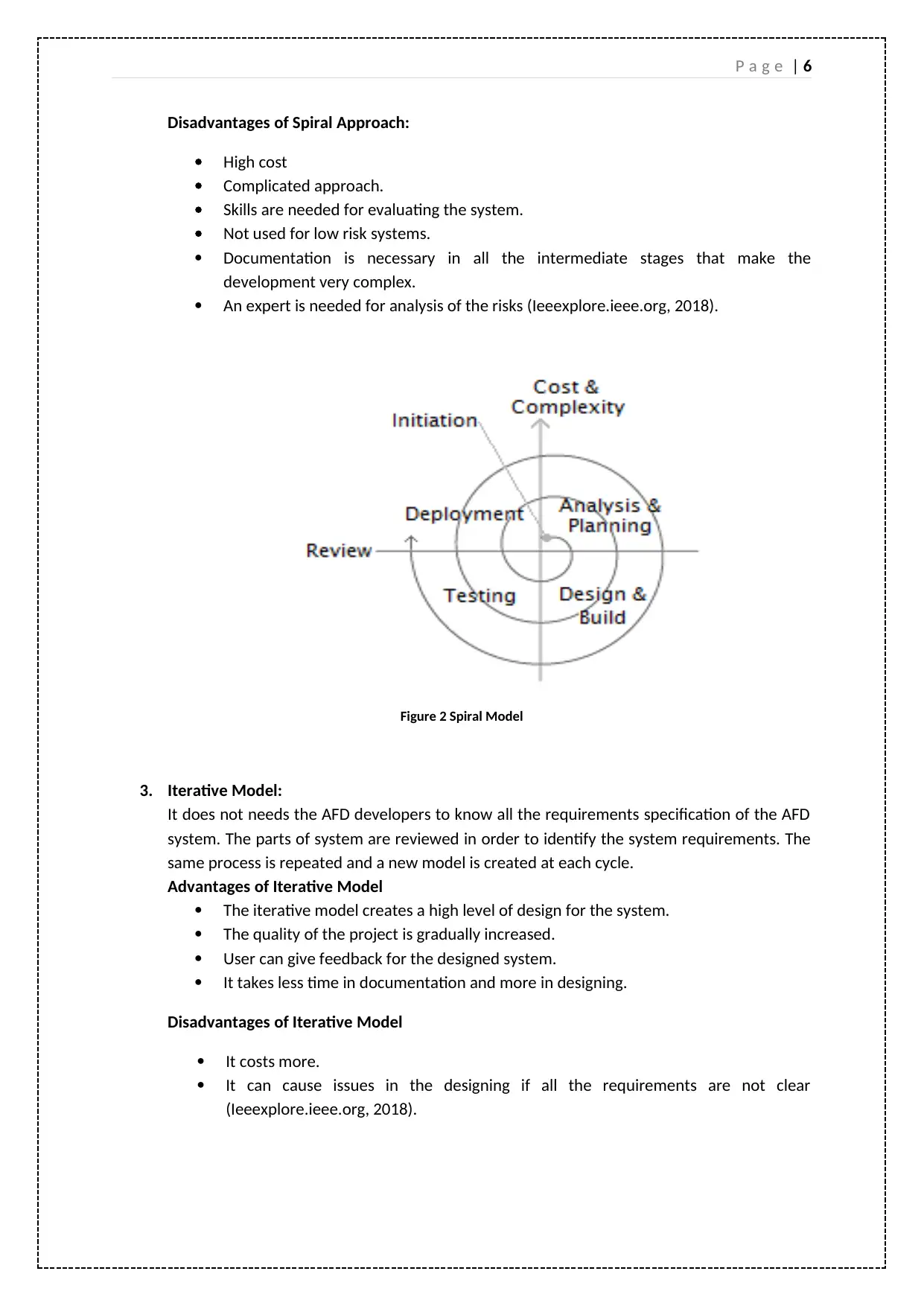
P a g e | 6
Disadvantages of Spiral Approach:
High cost
Complicated approach.
Skills are needed for evaluating the system.
Not used for low risk systems.
Documentation is necessary in all the intermediate stages that make the
development very complex.
An expert is needed for analysis of the risks (Ieeexplore.ieee.org, 2018).
Figure 2 Spiral Model
3. Iterative Model:
It does not needs the AFD developers to know all the requirements specification of the AFD
system. The parts of system are reviewed in order to identify the system requirements. The
same process is repeated and a new model is created at each cycle.
Advantages of Iterative Model
The iterative model creates a high level of design for the system.
The quality of the project is gradually increased.
User can give feedback for the designed system.
It takes less time in documentation and more in designing.
Disadvantages of Iterative Model
It costs more.
It can cause issues in the designing if all the requirements are not clear
(Ieeexplore.ieee.org, 2018).
Disadvantages of Spiral Approach:
High cost
Complicated approach.
Skills are needed for evaluating the system.
Not used for low risk systems.
Documentation is necessary in all the intermediate stages that make the
development very complex.
An expert is needed for analysis of the risks (Ieeexplore.ieee.org, 2018).
Figure 2 Spiral Model
3. Iterative Model:
It does not needs the AFD developers to know all the requirements specification of the AFD
system. The parts of system are reviewed in order to identify the system requirements. The
same process is repeated and a new model is created at each cycle.
Advantages of Iterative Model
The iterative model creates a high level of design for the system.
The quality of the project is gradually increased.
User can give feedback for the designed system.
It takes less time in documentation and more in designing.
Disadvantages of Iterative Model
It costs more.
It can cause issues in the designing if all the requirements are not clear
(Ieeexplore.ieee.org, 2018).
⊘ This is a preview!⊘
Do you want full access?
Subscribe today to unlock all pages.

Trusted by 1+ million students worldwide

P a g e | 7
Figure 3 Iterative Model
4. Incremental Model:
In this model, the requirements of AFD are made to divide in various sorts. Many cycles of
development takes place. The modules of AFD are then passed through the requirement
identification, design development, implementation and then testing.
Advantages of Incremental Model:
The working AFD will be created very quickly during the early phases of
development.
Build more flexible model.
Risk is managed.
Disadvantages of Incremental Model:
Better planning is needed
The developers of AFD will need to know the whole system.
Higher cost than waterfall model
Figure 4 Incremental Model
Figure 3 Iterative Model
4. Incremental Model:
In this model, the requirements of AFD are made to divide in various sorts. Many cycles of
development takes place. The modules of AFD are then passed through the requirement
identification, design development, implementation and then testing.
Advantages of Incremental Model:
The working AFD will be created very quickly during the early phases of
development.
Build more flexible model.
Risk is managed.
Disadvantages of Incremental Model:
Better planning is needed
The developers of AFD will need to know the whole system.
Higher cost than waterfall model
Figure 4 Incremental Model
Paraphrase This Document
Need a fresh take? Get an instant paraphrase of this document with our AI Paraphraser
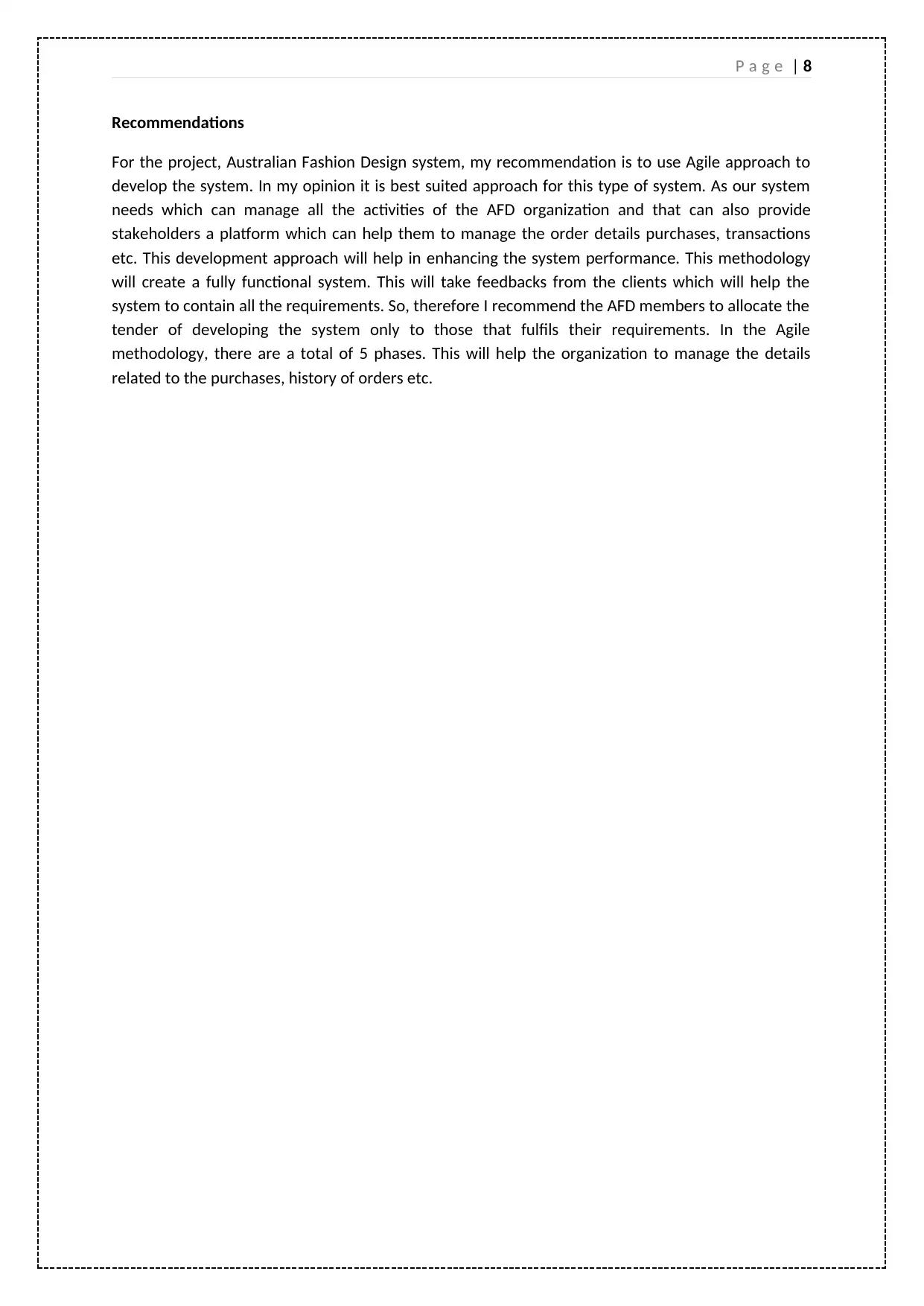
P a g e | 8
Recommendations
For the project, Australian Fashion Design system, my recommendation is to use Agile approach to
develop the system. In my opinion it is best suited approach for this type of system. As our system
needs which can manage all the activities of the AFD organization and that can also provide
stakeholders a platform which can help them to manage the order details purchases, transactions
etc. This development approach will help in enhancing the system performance. This methodology
will create a fully functional system. This will take feedbacks from the clients which will help the
system to contain all the requirements. So, therefore I recommend the AFD members to allocate the
tender of developing the system only to those that fulfils their requirements. In the Agile
methodology, there are a total of 5 phases. This will help the organization to manage the details
related to the purchases, history of orders etc.
Recommendations
For the project, Australian Fashion Design system, my recommendation is to use Agile approach to
develop the system. In my opinion it is best suited approach for this type of system. As our system
needs which can manage all the activities of the AFD organization and that can also provide
stakeholders a platform which can help them to manage the order details purchases, transactions
etc. This development approach will help in enhancing the system performance. This methodology
will create a fully functional system. This will take feedbacks from the clients which will help the
system to contain all the requirements. So, therefore I recommend the AFD members to allocate the
tender of developing the system only to those that fulfils their requirements. In the Agile
methodology, there are a total of 5 phases. This will help the organization to manage the details
related to the purchases, history of orders etc.
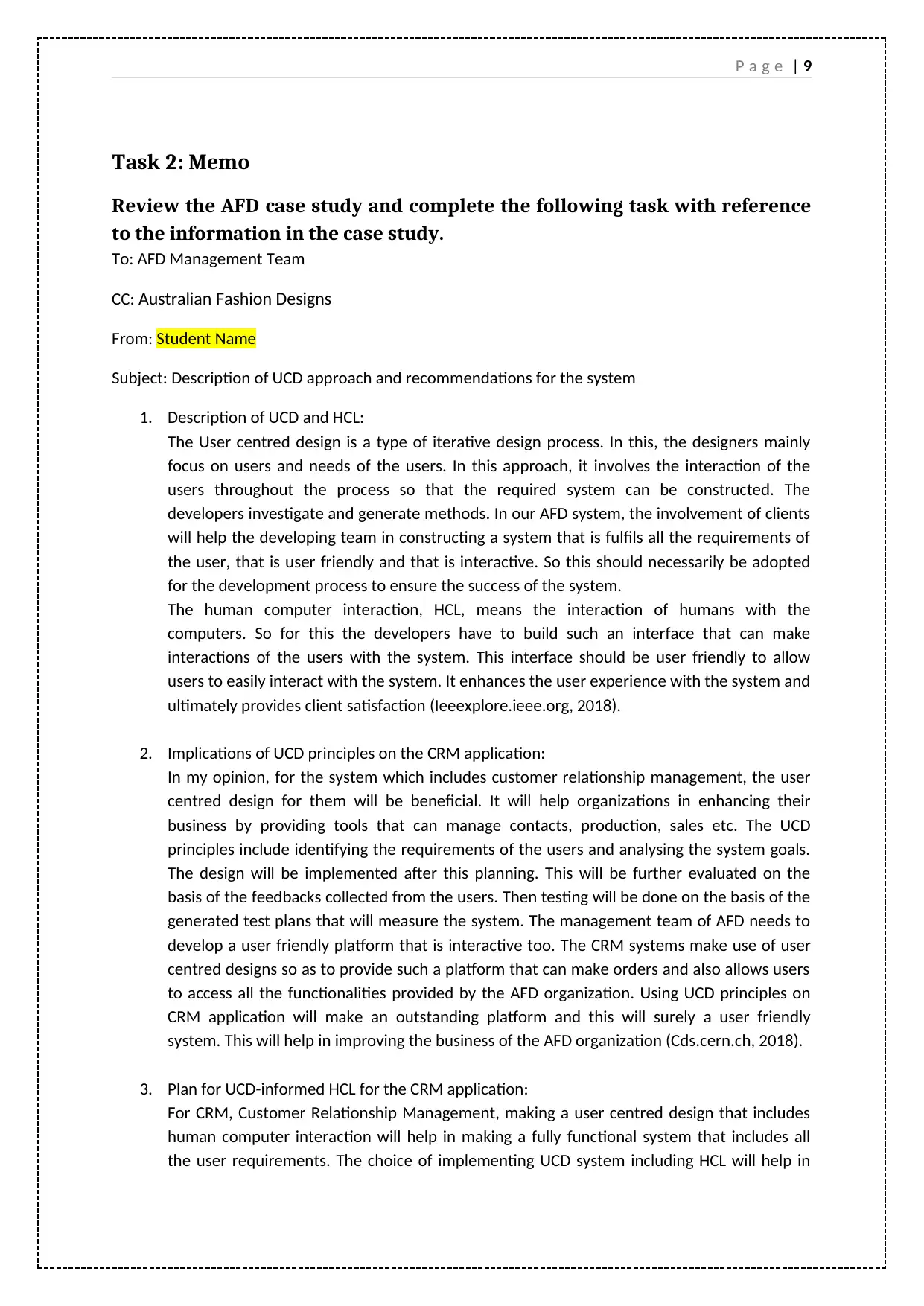
P a g e | 9
Task 2: Memo
Review the AFD case study and complete the following task with reference
to the information in the case study.
To: AFD Management Team
CC: Australian Fashion Designs
From: Student Name
Subject: Description of UCD approach and recommendations for the system
1. Description of UCD and HCL:
The User centred design is a type of iterative design process. In this, the designers mainly
focus on users and needs of the users. In this approach, it involves the interaction of the
users throughout the process so that the required system can be constructed. The
developers investigate and generate methods. In our AFD system, the involvement of clients
will help the developing team in constructing a system that is fulfils all the requirements of
the user, that is user friendly and that is interactive. So this should necessarily be adopted
for the development process to ensure the success of the system.
The human computer interaction, HCL, means the interaction of humans with the
computers. So for this the developers have to build such an interface that can make
interactions of the users with the system. This interface should be user friendly to allow
users to easily interact with the system. It enhances the user experience with the system and
ultimately provides client satisfaction (Ieeexplore.ieee.org, 2018).
2. Implications of UCD principles on the CRM application:
In my opinion, for the system which includes customer relationship management, the user
centred design for them will be beneficial. It will help organizations in enhancing their
business by providing tools that can manage contacts, production, sales etc. The UCD
principles include identifying the requirements of the users and analysing the system goals.
The design will be implemented after this planning. This will be further evaluated on the
basis of the feedbacks collected from the users. Then testing will be done on the basis of the
generated test plans that will measure the system. The management team of AFD needs to
develop a user friendly platform that is interactive too. The CRM systems make use of user
centred designs so as to provide such a platform that can make orders and also allows users
to access all the functionalities provided by the AFD organization. Using UCD principles on
CRM application will make an outstanding platform and this will surely a user friendly
system. This will help in improving the business of the AFD organization (Cds.cern.ch, 2018).
3. Plan for UCD-informed HCL for the CRM application:
For CRM, Customer Relationship Management, making a user centred design that includes
human computer interaction will help in making a fully functional system that includes all
the user requirements. The choice of implementing UCD system including HCL will help in
Task 2: Memo
Review the AFD case study and complete the following task with reference
to the information in the case study.
To: AFD Management Team
CC: Australian Fashion Designs
From: Student Name
Subject: Description of UCD approach and recommendations for the system
1. Description of UCD and HCL:
The User centred design is a type of iterative design process. In this, the designers mainly
focus on users and needs of the users. In this approach, it involves the interaction of the
users throughout the process so that the required system can be constructed. The
developers investigate and generate methods. In our AFD system, the involvement of clients
will help the developing team in constructing a system that is fulfils all the requirements of
the user, that is user friendly and that is interactive. So this should necessarily be adopted
for the development process to ensure the success of the system.
The human computer interaction, HCL, means the interaction of humans with the
computers. So for this the developers have to build such an interface that can make
interactions of the users with the system. This interface should be user friendly to allow
users to easily interact with the system. It enhances the user experience with the system and
ultimately provides client satisfaction (Ieeexplore.ieee.org, 2018).
2. Implications of UCD principles on the CRM application:
In my opinion, for the system which includes customer relationship management, the user
centred design for them will be beneficial. It will help organizations in enhancing their
business by providing tools that can manage contacts, production, sales etc. The UCD
principles include identifying the requirements of the users and analysing the system goals.
The design will be implemented after this planning. This will be further evaluated on the
basis of the feedbacks collected from the users. Then testing will be done on the basis of the
generated test plans that will measure the system. The management team of AFD needs to
develop a user friendly platform that is interactive too. The CRM systems make use of user
centred designs so as to provide such a platform that can make orders and also allows users
to access all the functionalities provided by the AFD organization. Using UCD principles on
CRM application will make an outstanding platform and this will surely a user friendly
system. This will help in improving the business of the AFD organization (Cds.cern.ch, 2018).
3. Plan for UCD-informed HCL for the CRM application:
For CRM, Customer Relationship Management, making a user centred design that includes
human computer interaction will help in making a fully functional system that includes all
the user requirements. The choice of implementing UCD system including HCL will help in
⊘ This is a preview!⊘
Do you want full access?
Subscribe today to unlock all pages.

Trusted by 1+ million students worldwide

P a g e | 10
designing the system. As agile methodology is used for implementing the development of
the system, the use of UCD will simplify the task of development. And a fully functional and
user friendly system will be obtained as the output. As the AFD system includes the
involvement of users so opting this combination as a part of development will surely be a
success. With this, it will help the customers to use the system. This system produces the
sales report at the month end including the discounts for the big orders. It can analyse the
user interaction with the system. Then in future if any update is needed then it can also be
done because we have used the Agile methodology for the development of the system. The
expertise guidance will motivate to incorporate all the user requirements in our system.
4. Recommendation - Theory applied to a case:
My recommendation to the management team of AFD is to use the principles of the UCD
along with the Agile methodology for developing the system that will help customers and
the organization to increase their profit part. With principles of the UCD, we can develop
such a interface that will help users to place their orders when needed and it will also help
the team of AFD to manage the business details such as orders, purchases, transactions,
shipping etc. In the given Case study the management team of AFD will need to produce one
summary report at month end which will include all the details related to sales, orders etc.
So therefore UCD plan embedded in the Agile methodology is what I recommend as it will
surely fulfil the user requirements and will provide user friendly interface. This interface can
be easily adopted by the customers. A systematic system will be developed that will enhance
the functioning of the system.
At last I would like to give tons of thanks for providing me this wonderful opportunity to share my
views and suggestions for the system development that can provide a system for the use of both
customers and the AFD team members.
designing the system. As agile methodology is used for implementing the development of
the system, the use of UCD will simplify the task of development. And a fully functional and
user friendly system will be obtained as the output. As the AFD system includes the
involvement of users so opting this combination as a part of development will surely be a
success. With this, it will help the customers to use the system. This system produces the
sales report at the month end including the discounts for the big orders. It can analyse the
user interaction with the system. Then in future if any update is needed then it can also be
done because we have used the Agile methodology for the development of the system. The
expertise guidance will motivate to incorporate all the user requirements in our system.
4. Recommendation - Theory applied to a case:
My recommendation to the management team of AFD is to use the principles of the UCD
along with the Agile methodology for developing the system that will help customers and
the organization to increase their profit part. With principles of the UCD, we can develop
such a interface that will help users to place their orders when needed and it will also help
the team of AFD to manage the business details such as orders, purchases, transactions,
shipping etc. In the given Case study the management team of AFD will need to produce one
summary report at month end which will include all the details related to sales, orders etc.
So therefore UCD plan embedded in the Agile methodology is what I recommend as it will
surely fulfil the user requirements and will provide user friendly interface. This interface can
be easily adopted by the customers. A systematic system will be developed that will enhance
the functioning of the system.
At last I would like to give tons of thanks for providing me this wonderful opportunity to share my
views and suggestions for the system development that can provide a system for the use of both
customers and the AFD team members.
Paraphrase This Document
Need a fresh take? Get an instant paraphrase of this document with our AI Paraphraser
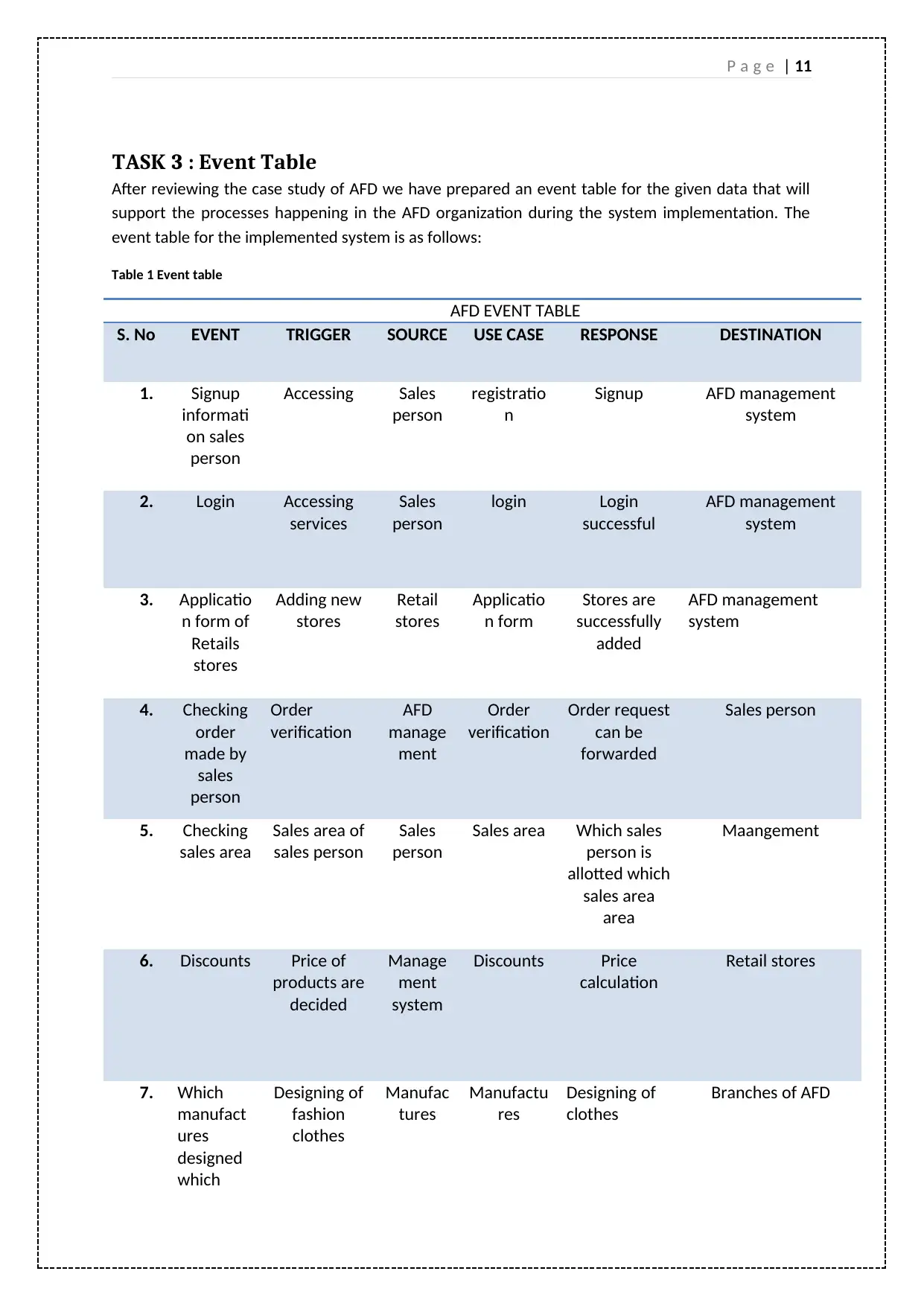
P a g e | 11
TASK 3 : Event Table
After reviewing the case study of AFD we have prepared an event table for the given data that will
support the processes happening in the AFD organization during the system implementation. The
event table for the implemented system is as follows:
Table 1 Event table
AFD EVENT TABLE
S. No EVENT TRIGGER SOURCE USE CASE RESPONSE DESTINATION
1. Signup
informati
on sales
person
Accessing Sales
person
registratio
n
Signup AFD management
system
2. Login Accessing
services
Sales
person
login Login
successful
AFD management
system
3. Applicatio
n form of
Retails
stores
Adding new
stores
Retail
stores
Applicatio
n form
Stores are
successfully
added
AFD management
system
4. Checking
order
made by
sales
person
Order
verification
AFD
manage
ment
Order
verification
Order request
can be
forwarded
Sales person
5. Checking
sales area
Sales area of
sales person
Sales
person
Sales area Which sales
person is
allotted which
sales area
area
Maangement
6. Discounts Price of
products are
decided
Manage
ment
system
Discounts Price
calculation
Retail stores
7. Which
manufact
ures
designed
which
Designing of
fashion
clothes
Manufac
tures
Manufactu
res
Designing of
clothes
Branches of AFD
TASK 3 : Event Table
After reviewing the case study of AFD we have prepared an event table for the given data that will
support the processes happening in the AFD organization during the system implementation. The
event table for the implemented system is as follows:
Table 1 Event table
AFD EVENT TABLE
S. No EVENT TRIGGER SOURCE USE CASE RESPONSE DESTINATION
1. Signup
informati
on sales
person
Accessing Sales
person
registratio
n
Signup AFD management
system
2. Login Accessing
services
Sales
person
login Login
successful
AFD management
system
3. Applicatio
n form of
Retails
stores
Adding new
stores
Retail
stores
Applicatio
n form
Stores are
successfully
added
AFD management
system
4. Checking
order
made by
sales
person
Order
verification
AFD
manage
ment
Order
verification
Order request
can be
forwarded
Sales person
5. Checking
sales area
Sales area of
sales person
Sales
person
Sales area Which sales
person is
allotted which
sales area
area
Maangement
6. Discounts Price of
products are
decided
Manage
ment
system
Discounts Price
calculation
Retail stores
7. Which
manufact
ures
designed
which
Designing of
fashion
clothes
Manufac
tures
Manufactu
res
Designing of
clothes
Branches of AFD
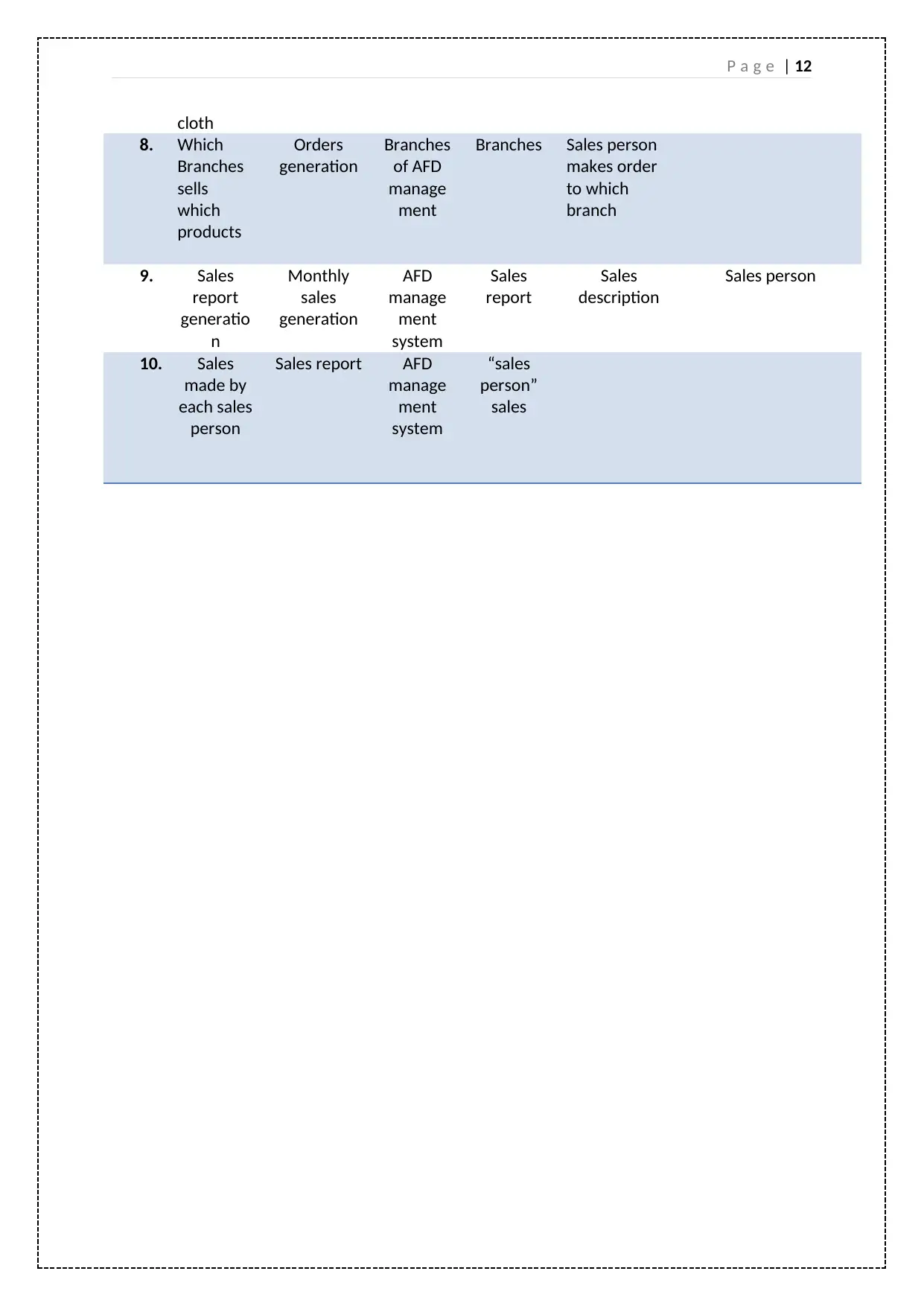
P a g e | 12
cloth
8. Which
Branches
sells
which
products
Orders
generation
Branches
of AFD
manage
ment
Branches Sales person
makes order
to which
branch
9. Sales
report
generatio
n
Monthly
sales
generation
AFD
manage
ment
system
Sales
report
Sales
description
Sales person
10. Sales
made by
each sales
person
Sales report AFD
manage
ment
system
“sales
person”
sales
cloth
8. Which
Branches
sells
which
products
Orders
generation
Branches
of AFD
manage
ment
Branches Sales person
makes order
to which
branch
9. Sales
report
generatio
n
Monthly
sales
generation
AFD
manage
ment
system
Sales
report
Sales
description
Sales person
10. Sales
made by
each sales
person
Sales report AFD
manage
ment
system
“sales
person”
sales
⊘ This is a preview!⊘
Do you want full access?
Subscribe today to unlock all pages.

Trusted by 1+ million students worldwide
1 out of 20
Related Documents
Your All-in-One AI-Powered Toolkit for Academic Success.
+13062052269
info@desklib.com
Available 24*7 on WhatsApp / Email
![[object Object]](/_next/static/media/star-bottom.7253800d.svg)
Unlock your academic potential
Copyright © 2020–2025 A2Z Services. All Rights Reserved. Developed and managed by ZUCOL.





